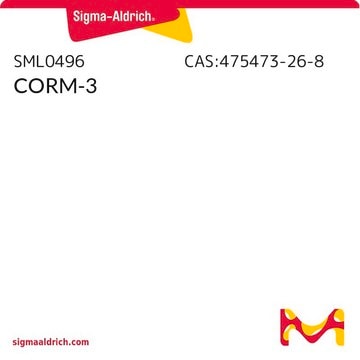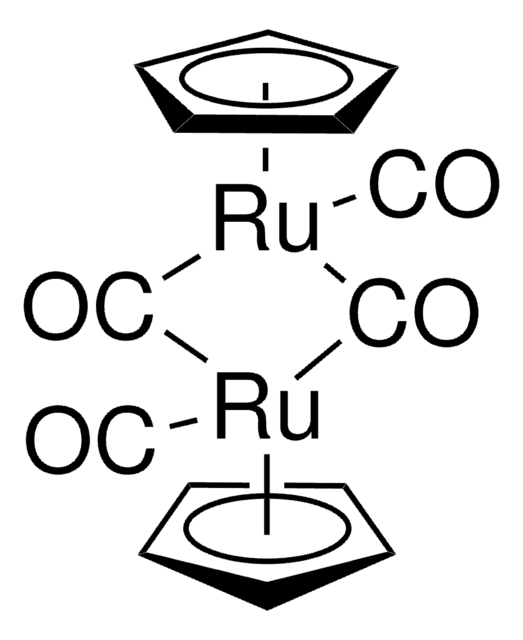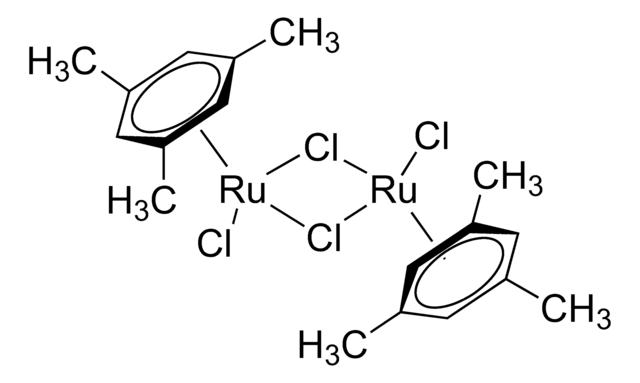This product is not assigned an expiration date or recommended retest date. Products with no expiration date or recommended retest date should be routinely inspected by customers to ensure they perform as expected. These products are also subject to a one year warranty from the date of shipment. For more information you may access the "Product Dating Information" document under "ADDITIONAL USEFUL DOCUMENTS ABOUT OUR PRODUCTS" at the bottom of the Quality Services page with this link: https://www.sigmaaldrich.com/life-science/quality-and-regulatory-management/quality-services.
288144
Tricarbonyldichlororuthenium(II) dimer
Synonym(s):
CORM-2
Select a Size
About This Item
Recommended Products
Quality Level
reaction suitability
core: ruthenium
reagent type: catalyst
SMILES string
[C-]#[O+].[C-]#[O+].[C-]#[O+].[C-]#[O+].[C-]#[O+].[C-]#[O+].Cl[Ru]Cl.Cl[Ru]Cl
InChI
1S/6CO.4ClH.2Ru/c6*1-2;;;;;;/h;;;;;;4*1H;;/q;;;;;;;;;;2*+2/p-4
InChI key
JYHHJVKGDCZCCL-UHFFFAOYSA-J
Application
- Enhancement of coagulation and attenuation of vulnerability to fibrinolysis
- Investigations of P2X4 as a possible target
- Possible modification of thrombus growth or disintegration
- Enhances fibrinogen as a substrate for thrombin
- Regulation of ion transport by gasotransmitters
Used as a CO donor for reactive oxygen species mediated bacterial killing
signalword
Warning
Hazard Classifications
Acute Tox. 4 Oral - Eye Irrit. 2 - Skin Irrit. 2 - STOT SE 3
target_organs
Respiratory system
Storage Class
11 - Combustible Solids
wgk_germany
WGK 3
flash_point_f
Not applicable
flash_point_c
Not applicable
ppe
dust mask type N95 (US), Eyeshields, Gloves
Choose from one of the most recent versions:
Already Own This Product?
Find documentation for the products that you have recently purchased in the Document Library.
Customers Also Viewed
-
How long is TRICARBONYLDICHLORUTHENIUM (II) DIMER stable for when stored in a cool place? Does CO release decrease with long-term storage?
1 answer-
Helpful?
-
-
How long is it stable when stored in a cool place without dissolving?
1 answer-
This product is not assigned an expiration date or recommended retest date. Products with no expiration date or recommended retest date should be routinely inspected by customers to ensure they perform as expected. These products are also subject to a one year warranty from the date of shipment. For more information you may access the "Product Dating Information" document under "ADDITIONAL USEFUL DOCUMENTS ABOUT OUR PRODUCTS" at the bottom of the Quality Services page with this link: https://www.sigmaaldrich.com/life-science/quality-and-regulatory-management/quality-services.
Helpful?
-
-
How does Tricarbonyldichlororuthenium (II) dimer release CO in vitro? Does it reacts to a specific lightwave or pH?
1 answer-
This product has not been tested for in vivo or in vitro applications. Please see the link below to review a publication that may be helpful:
https://www.ncbi.nlm.nih.gov/pmc/articles/PMC4604159/Helpful?
-
-
What is the Department of Transportation shipping information for this product?
1 answer-
Transportation information can be found in Section 14 of the product's (M)SDS.To access the shipping information for this material, use the link on the product detail page for the product.
Helpful?
-
-
What are the potential applications for Product 288144, Tricarbonyldichlororuthenium(II) dimer?
1 answer-
This product has been reported and used as a carbon monoxide releasing agent in biological systems, and a ruthenium catalyst.
Helpful?
-
-
What solvents can be used to dissolve Product 288144, Tricarbonyldichlororuthenium(II) dimer?
1 answer-
This product is slightly soluble in chloroform and dichloromethane. It is also soluble in methanol and tetrahydrofuran, but it forms a solvent adduct.
Helpful?
-
Active Filters
Our team of scientists has experience in all areas of research including Life Science, Material Science, Chemical Synthesis, Chromatography, Analytical and many others.
Contact Technical Service












![[Ru(phen)3]Cl2 ≥95%](/deepweb/assets/sigmaaldrich/product/structures/955/596/46f63eaa-39f8-4058-847d-cef0862ada92/640/46f63eaa-39f8-4058-847d-cef0862ada92.png)


